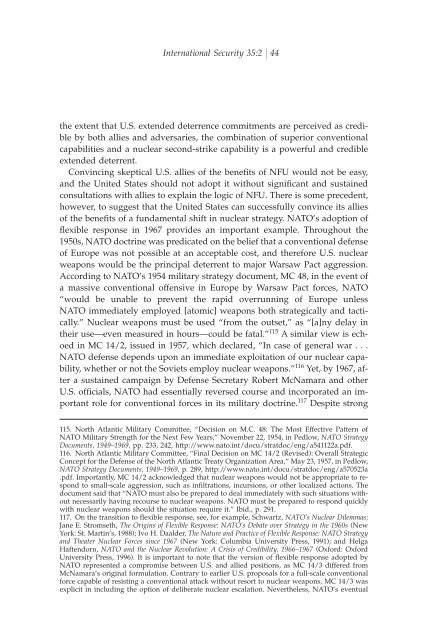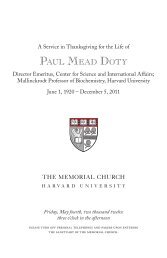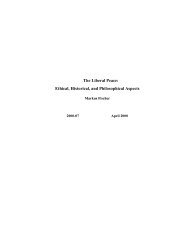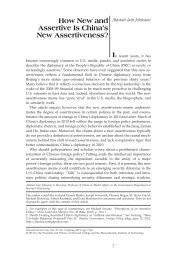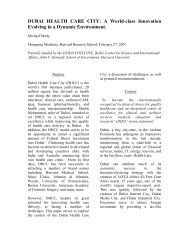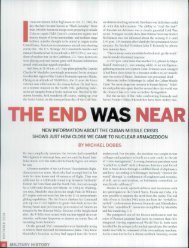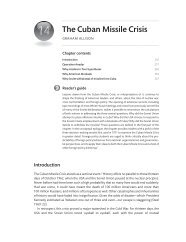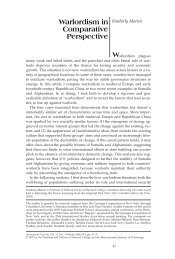The Next Step for U.S. Nuclear Policy - Project MUSE
The Next Step for U.S. Nuclear Policy - Project MUSE
The Next Step for U.S. Nuclear Policy - Project MUSE
You also want an ePaper? Increase the reach of your titles
YUMPU automatically turns print PDFs into web optimized ePapers that Google loves.
International Security 35:2 44<br />
the extent that U.S. extended deterrence commitments are perceived as credible<br />
by both allies and adversaries, the combination of superior conventional<br />
capabilities and a nuclear second-strike capability is a powerful and credible<br />
extended deterrent.<br />
Convincing skeptical U.S. allies of the beneªts of NFU would not be easy,<br />
and the United States should not adopt it without signiªcant and sustained<br />
consultations with allies to explain the logic of NFU. <strong>The</strong>re is some precedent,<br />
however, to suggest that the United States can successfully convince its allies<br />
of the beneªts of a fundamental shift in nuclear strategy. NATO’s adoption of<br />
ºexible response in 1967 provides an important example. Throughout the<br />
1950s, NATO doctrine was predicated on the belief that a conventional defense<br />
of Europe was not possible at an acceptable cost, and there<strong>for</strong>e U.S. nuclear<br />
weapons would be the principal deterrent to major Warsaw Pact aggression.<br />
According to NATO’s 1954 military strategy document, MC 48, in the event of<br />
a massive conventional offensive in Europe by Warsaw Pact <strong>for</strong>ces, NATO<br />
“would be unable to prevent the rapid overrunning of Europe unless<br />
NATO immediately employed [atomic] weapons both strategically and tactically.”<br />
<strong>Nuclear</strong> weapons must be used “from the outset,” as “[a]ny delay in<br />
their use—even measured in hours—could be fatal.” 115 A similar view is echoed<br />
in MC 14/2, issued in 1957, which declared, “In case of general war . . .<br />
NATO defense depends upon an immediate exploitation of our nuclear capability,<br />
whether or not the Soviets employ nuclear weapons.” 116 Yet, by 1967, after<br />
a sustained campaign by Defense Secretary Robert McNamara and other<br />
U.S. ofªcials, NATO had essentially reversed course and incorporated an important<br />
role <strong>for</strong> conventional <strong>for</strong>ces in its military doctrine. 117 Despite strong<br />
115. North Atlantic Military Committee, “Decision on M.C. 48: <strong>The</strong> Most Effective Pattern of<br />
NATO Military Strength <strong>for</strong> the <strong>Next</strong> Few Years,” November 22, 1954, in Pedlow, NATO Strategy<br />
Documents, 1949–1969, pp. 233, 242, http://www.nato.int/docu/stratdoc/eng/a541122a.pdf.<br />
116. North Atlantic Military Committee, “Final Decision on MC 14/2 (Revised): Overall Strategic<br />
Concept <strong>for</strong> the Defense of the North Atlantic Treaty Organization Area,” May 23, 1957, in Pedlow,<br />
NATO Strategy Documents, 1949–1969, p. 289, http://www.nato.int/docu/stratdoc/eng/a570523a<br />
.pdf. Importantly, MC 14/2 acknowledged that nuclear weapons would not be appropriate to respond<br />
to small-scale aggression, such as inªltrations, incursions, or other localized actions. <strong>The</strong><br />
document said that “NATO must also be prepared to deal immediately with such situations without<br />
necessarily having recourse to nuclear weapons. NATO must be prepared to respond quickly<br />
with nuclear weapons should the situation require it.” Ibid., p. 291.<br />
117. On the transition to ºexible response, see, <strong>for</strong> example, Schwartz, NATO’s <strong>Nuclear</strong> Dilemmas;<br />
Jane E. Stromseth, <strong>The</strong> Origins of Flexible Response: NATO’s Debate over Strategy in the 1960s (New<br />
York: St. Martin’s, 1988); Ivo H. Daalder, <strong>The</strong> Nature and Practice of Flexible Response: NATO Strategy<br />
and <strong>The</strong>ater <strong>Nuclear</strong> Forces since 1967 (New York: Columbia University Press, 1991); and Helga<br />
Haftendorn, NATO and the <strong>Nuclear</strong> Revolution: A Crisis of Credibility, 1966–1967 (Ox<strong>for</strong>d: Ox<strong>for</strong>d<br />
University Press, 1996). It is important to note that the version of ºexible response adopted by<br />
NATO represented a compromise between U.S. and allied positions, as MC 14/3 differed from<br />
McNamara’s original <strong>for</strong>mulation. Contrary to earlier U.S. proposals <strong>for</strong> a full-scale conventional<br />
<strong>for</strong>ce capable of resisting a conventional attack without resort to nuclear weapons, MC 14/3 was<br />
explicit in including the option of deliberate nuclear escalation. Nevertheless, NATO’s eventual


